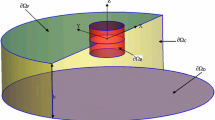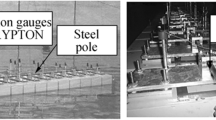Abstract
This paper describes techniques to synthesize deterministic task-related ‘rogue’ waves or critical wave groups for engineering applications. These extreme events, represented by local characteristics like tailored design wave sequences, are integrated in a random or deterministic seaway with a defined energy density spectrum. If a strictly deterministic process is established, cause and effect are clearly related: at any position the non-linear surface elevation and the associated pressure field as well as the velocity and acceleration fields can be determined. Also the point of wave/structure interaction can be selected arbitrarily, and any test can be repeated deliberately. Wave-structure interaction is decomposable into subsequent steps: surface elevation — wave kinematics and dynamics — forces on structure components and the entire structure — structure motions.
Firstly, the generation of linear wave groups is presented. The method is based on the wave focussing technique. For a target Fourier wave spectrum a tailored wave sequence can be assigned to a selected position. This wave train is linearly transformed back to the wave maker and — by introducing the electro-hydraulic and hydrodynamic transfer functions of the wave generator — the associated control signal is calculated.
The generation of steeper and higher wave groups requires a more sophisticated approach as propagation velocity increases with wave height. With a semi-empirical procedure the control signal of extremely high wave groups is determined, and the propagation of the associated wave train is calculated by iterative integration of coupled equations of particle tracks.
In general, extremely high ‘rogue’ waves or critical wave groups are rare events embedded in a random seaway. The most efficient and economical procedure to simulate and generate such a specified wave scenario for a given design variance spectrum is based on the appropriate superposition of component waves or wavelets. The desired characteristics like wave height and period as well as crest height and steepness are defined by an appropriate objective function. The subsequent optimization of the initially random phase spectrum is solved by a Sequential Quadratic Programming method (SQP). The linear synthetization of critical wave events is expanded to a fully nonlinear simulation by applying the subplex method.
For investigating the consequences of specific extreme sea conditions this paper analyses the seakeeping behaviour of a semisubmersible and a FPSO in the Draupner New Year Wave, embedded in extreme irregular seas. In addition, extreme roll motions and the capsizing of a Ro-Ro vessel in a severe storm wave group are evaluated, and the procedures for safe ship design and operation are discussed.
Similar content being viewed by others
References
Bouws, E., Günther, H., Rosenthal, W. and Vincent, C. (1985), “Similarity of the Wind Wave Spectrum in Finite Depth Water -1”. Spectral form, Journal of Geophysical Research, 90(C1).
Clauss, G. and Bergmann J. (1986). “Gaussian Wave Packets -a New Approach to Seakeeping Tests of Ocean structures”. Applied Ocean Research, Vol. 8(4).
Clauss, G. (1999). “Task-Related Wave Groups for Seakeeping Tests or Simulation of Design Storm Waves”. Applied Ocean Research, Vol. 21(5), pp. 219–234.
Clauss, G. (2002a). “Genesis of Design Wave Groups in Extreme Seas for the Evaluation of Wave/Structure Interaction”. In the 24th Symposium on Naval Hydrodynamics, Fukuoka.
Clauss, G. (2002b). “Dramas of the Sea: Episodic Waves and Their Impact on Offshore Structures”. Applied Ocean Research, Vol. 24(3), pp 147–161, ISSN 0141-1187.
Clauss, G. and Habel, R. (2000).“Artificial Reefs for Coastal Protection — Transient Viscous Computation and Experimental Evaluation”. 27th International Conference on Coastal Engineering ICCE’2000, Sydney, Australia.
Clauss, G. and Hennig, J. (2001). “Tailored Transient Wave Packet Sequences for Computer Controlled Seakeeping Tests”. 20th International Conference on Offshore Mechanics and Arctic Engineering (OMAE), ISBN 0-7918-3529-4, paper OFT-1081, Rio de Janeiro, Brazil.
Clauss, G. and Hennig, J. (2002). “Computer Controlled Capsizing Tests Using Tailored Wave Sequences”. 21st International Conference on Offshore Mechanics and Arctic Engineering, OMAE 2002-28297, ISBN 0-7918-3599-5, Oslo, Norway.
Clauss, G., Pfennig, J., Cramer, PL, Krüger, S. (2003). “Development of Safer Ships by Deterministic Analysis of Extreme Roll Motions in Harsh Seas”. 22nd International Conference on Offshore Mechanics and Arctic Engineering, OMAE 2003-37174, Cancun, Mexico.
Clauss, G. and Kühnlein, W. (1995).“Transient Wave Packets — An Efficient Technique for Seakeeping Tests of Self-Propelled Models in Oblique Waves.” Third International Conference on Fast Sea Transportation, Lübeck-Travemünde, Germany.
Clauss, G. and Kühnlein, W. (1997). “Simulation of Design Storm Wave Conditions with Tailored Wave Groups”. 7th International Offshore and Polar Engineering Conference (ISOPE), pp. 228–237, Honolulu, Hawaii, USA.
Clauss, G., Pakozdi, C. and Steinhagen, U. (2001). “Experimetal Simulation of Tailored Design Wave Sequences in Extreme Seas”. 11th International Offshore and Polar Engineering Conference (ISOPE), ISBN 1-880653-54-0, Vol. 3, JSC-MP-05, Stavanger, Norway.
Clauss, G., Schmittner, C. and Stutz, K. (2002). “Time-Domain Investigations of a Semisubmersible in Rogue Waves”. 21st International Conference on Offshore Mechanics and Arctic Engineering, OMAE 2002-28450, ISBN 0-7918-3599-5, Oslo, Norway.
Clauss, G. and Steinhagen, U. (1999). “Numerical Simulation of Nonlinear Transient Waves and its Validation by Laboratory Data”. 9th International Offshore and Polar Engineering Conference (ISOPE), Vol.3, pp. 368–375, Brest, France.
Clauss, G. and Steinhagen, U. (2000). “Optimization of Transient Design Waves in Random Sea”. 10th International Offshore and Polar Engineering Conference (ISOPE), Vol.3, pp.229–236, Seatle, USA.
Clauss, G. and Steinhagen, U. (2001). “Generation and Numerical Simulation of Predetermined Nonlinear Wave Sequences in Random Seaways”. 20th International Conference on Offshore Mechanics and Arctic Engineering (OMAE), ISBN 0-7918-3529-4, paper OFT-1230, Rio de Janeiro, Brazil.
Clauss, G., Stutz, K. and Schmittner, C. (2004). “Rogue Wave Impact on Offshore Structures”. Offshore Technology Conference, OTC 16180, pp. 1–11, Houston, USA.
Cramer, H. and Krüger, S. (2001 ). “Numerical Capsizing Simulations and Consequences for Ship Design”. In STG Summermeeting Gdansk, Poland.
Cramer, H., Reichert, K., Hessner, K., Hennig, J., Clauss, G. F. (2004). “Seakeeping Simulations and Seaway Models and Parameters Supporting Ship Design and Operation”. The 9th International Symposium on Practical Design of Ships and Other Floating Structures, Lübeck-Travemünde, Germany.
Davis, M. and Zarnick, E. (1964). “Testing Ship Models in Transient Waves”. 5th Symposium on Naval Hydrodynamics.
Drake K. (1997).“Wave profiles associated with extreme loading in random waves”. RINA International Conference: Design and Operation for Abnormal Conditions, Glasgow, Scotland.
Faulkner (2000). “Rogue Waves — Defining Their Characteristics for Marine Design”. Rogue Waves 2000, Brest, France.
Faulkner, D. and Buckley, W. (1997). “Critical survival Conditions for Ship Design”. RINA International Conference: Design and Operation for Abnormal Conditions, Glasgow, Scotland.
France, W. K, Levadou, M., Treakle, T.W., Paulling, J. R., Michel, K. and Moore, C. (2001). “An Investigation of Head-Sea Parametric Rolling and its Influence on Container Lashing Systems”. In SNAME Annual Meeting.
Haver, S. (2000). “Some Evidence of the Existence of Socalled Freak Waves”. Rogue Waves 2000, Brest, France.
Haver, S. and Anderson, O.J. (2000). “Freak Waves: Rare Realizations of a Typical Population or Typical Realization of a Rare Population?” 10th International Offshore and Polar Engineering Conference (ISOPE), Seattle, USA.
Kjeldsen, S.P. (1996). “Example of Heavy Weather Damage Caused by Giant Waves.” Techno Marine, Bul. of the Society of Naval Architects of Japan, No. 820.
Kjeldsen, S.P. (1990). “Breaking Waves. Water Wave Kinematic, Kluwer Academic Publisher.” NATO ASI Series, ISBN 0-7923-0638-4, pp. 453–473.
Kjeldsen, S.P. and Myrhaug, D. (1997). “Breaking Waves in Deep Water and Resulting Wave Forces”. Offshore Technology Conference, OTC 3646.
Korsmeyer, F, Bingham, H. and Newman, J. (1999). “TiMIT-A Panel-Method Program for Transient Wave-Body Interactions”. Research Laboratory of Electronics, Massachusetts Institute of Technology.
Krüger, S. (2002). “Dynamic Stability of RoRo-Ships in Waves. Conference: Design and Safety of Ro-Ro Passenger Ships.” Kopenhagen, Danish Society of Naval Architecture and Marine Engineering.
Kühnlein, W. (1997). “Seegangsversuchstechnik mit Transienter Systemanregung.” PhD Thesis, Technische Universität Berlin, D83.
Mori, N., Yasuda, T. and Nakayama, S. (2000). “Statistical Properties of Freak Waves Observed in the Sea of Japan.” 10th International Offshore and Polar Engineering Conference (ISOPE), Seattle, USA.
Nelder, J. and Mead, R. (1965). “A Simplex Method for Function Minimization”. Computer Journal, 7, pp. 308–313.
Nickerson (1993). “Freak Waves!” Mariners Weather Log, NOAA, Vol. 37, No. 4, pp. 14–19.
Pakozdi, C. (2002). “Numerische Simulation Nichtlinearer Transienter Wellengruppen”. Bericht zum DFG-Vorhaben CI 35/30-1, Selbstverlag.
Rowan, T. (1990). “Functional Stability Analysis of Numerical Algorithms”. PhD Thesis, University of Texas at Austin.
Sand, S.E., Ottesen, H.N.E., Klinting, P., Gudmestad, O.T. and Sterndorff, M.J. (1990). “Freak Wave Kinematics. Water Wave Kinematics”. Kluwer Academic Publisher, NATO ASI Series, ISBN 0-7923-0638-4, pp. 535–549.
Söding, H. (1987).“Ermittlung der Kentergefahr aus Bewegungssimulationen”. Schiffstechnik 34.
Steinhagen, U. (2001). “Synthesizing Nonlinear Transient Gravity Waves in Random Seas”. PhD Thesis, Technische Universität Berlin, D83.
Takezawa, S. and Hirayama, T. (1976). “Advanced Experiment Techniques for Testing Ship Models in Transient Water Waves”. 11th Symposium on Naval Hydrodynamics.
Wolfram, J., Linfoot, B. and Stansell, P. (2000). “Long- and Short-Term Extreme Wave Statistics in the North Sea: 1994-1998”. Rogue Waves 2000, Brest, France.
Wu, G-X., Eatock Taylor, R. (1994). “Finite Element Analysis of Two-Dimensional Non-Linear Transient Water Waves”. Applied Ocean Research, 16(6), pp. 363–372.
Wu, G-X., Eatock Taylor, R. (1995). “Time Stepping Solutions of Two-Dimensional Non-Linear Wave Radiation Problem”. Ocean Engineering, 22(8), pp. 785–798.
Author information
Authors and Affiliations
Corresponding author
Additional information
Contribution to the 2’ International Workshop on Applied Offshore Hydrodynamics, LabOceano/COPPE/UFRJ, April 2005.
Rights and permissions
About this article
Cite this article
Clauss, G.F. Transient wave model testing for the evaluation of extreme motions and loads of ships and semisubmersibles. Mar. Syst. Ocean Technol. 1, 103–119 (2005). https://doi.org/10.1007/BF03449202
Published:
Issue Date:
DOI: https://doi.org/10.1007/BF03449202




